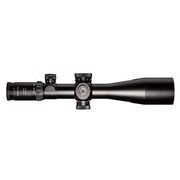A customer asked a good question the other day and I thought I would share it and the answer with you:
“On a variable power scope, the reticle in the first focal plane increases or decreases with the power setting ( correct me if I’m wrong) so th reticle appears the same size on the target. In the second focal plane the reticle stays the same size as the image increases or decreases in size with the power setting, so the reticle covers more area on low power, and less area on a higher power. What are the advantages and disadvantages of the reticle being in the 1st or 2nd focal plane and why aren’t there more scopes made with the reticle in the first focal plane? “
I answered:
“The assessments in your question are fully correct.
Europeans prefer first plane scopes because they legally and normally hunt a lot later than we do here, and larger reticles are easier to see on a target. First plane scopes also cannot change point of impact when changing magnification because the reticle does not move. The focus for the reticle and the parallax adjustment are such that when you change the parallax setting on a first plane scope you will sometimes lose sharp focus of your reticle. Therefore, most European scopes have a fast-focus eyepiece. This is for the reticle and nothing else. Most European scopes are also built on 30mm tubes, many of them steel instead of aluminum. They are in general bigger and heavier than their American counterparts.
First plane scopes with rangefinding type reticles may be used at any power. European glass is second to none. Second plane scopes or “American” scopes are smaller and lighter and can have point of impact change when changing magnification, and many of them, especially less expensive ones certainly do. The parallax setting on second plane scopes has nothing to do with the reticle focus, so fast-focus eyepieces are a matter of convenience and pretty much a useless feature. Set it once properly at high power and leave it forever. Second plane scopes also have a smaller appearing reticle on the target at high power than low power, which is extremely important for precise shot placement. Second plane scopes with rangefinding type reticles are designed to be used at one power only. BDC reticles are not excluded from this. Traditionally, second plane scopes are one inch, but 30mm tubes are gaining popularity rapidly. Most people think that the larger tube offers a brighter image, but this is not true, although it may in some cases offer better resolution. Steel scopes are a thing of the past here. Also, all of our glass is imported, with no exceptions I am aware of on magnified scopes.”

 Follow
Follow
2 Responses to >First Plane vs. Second Plane